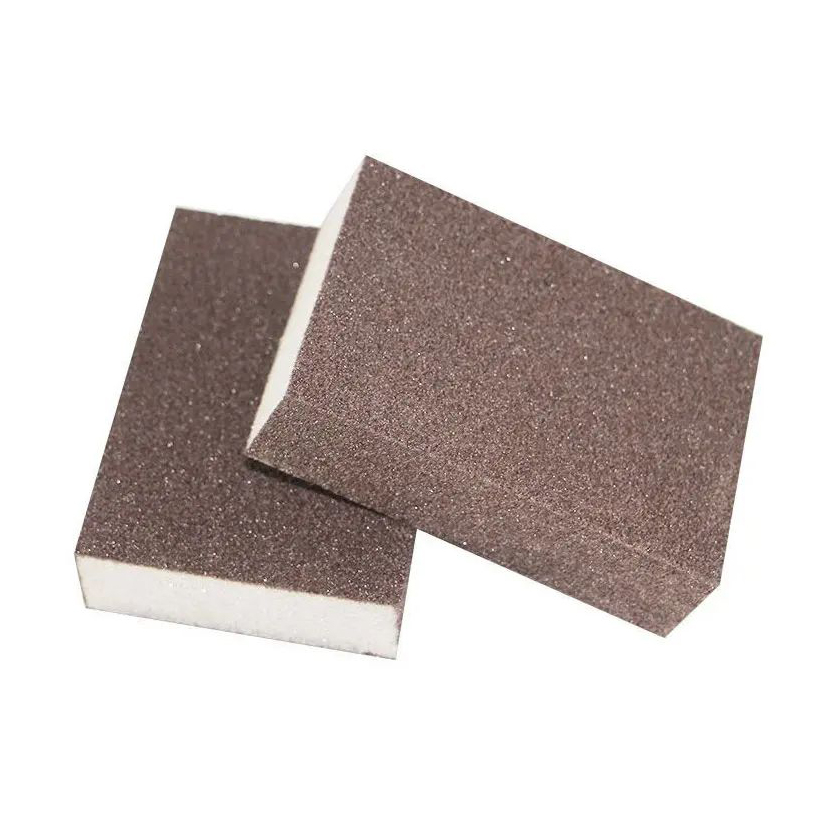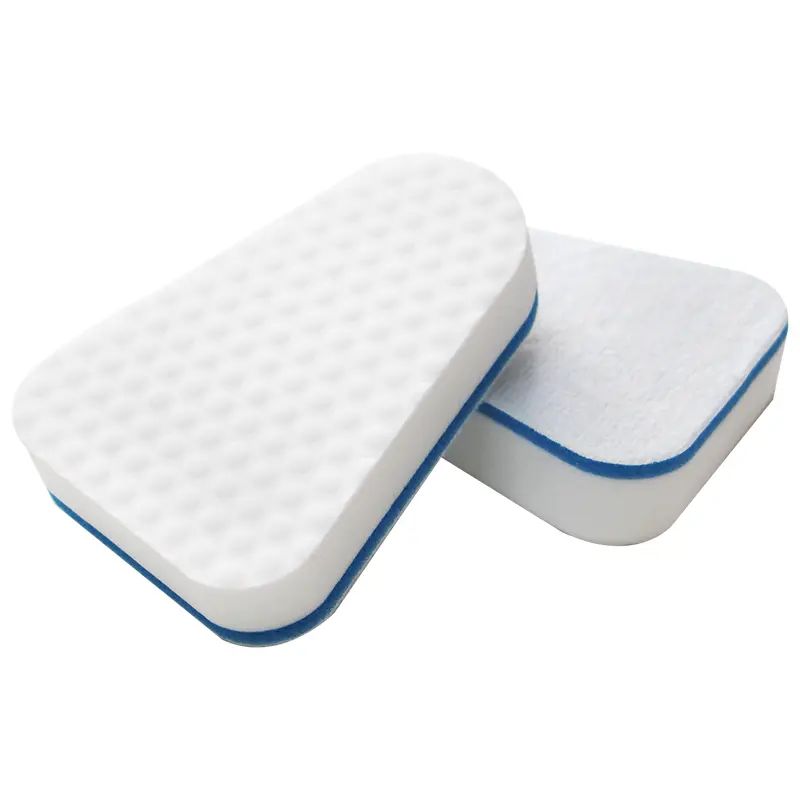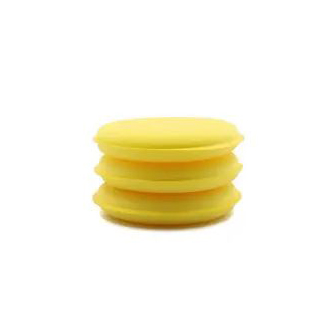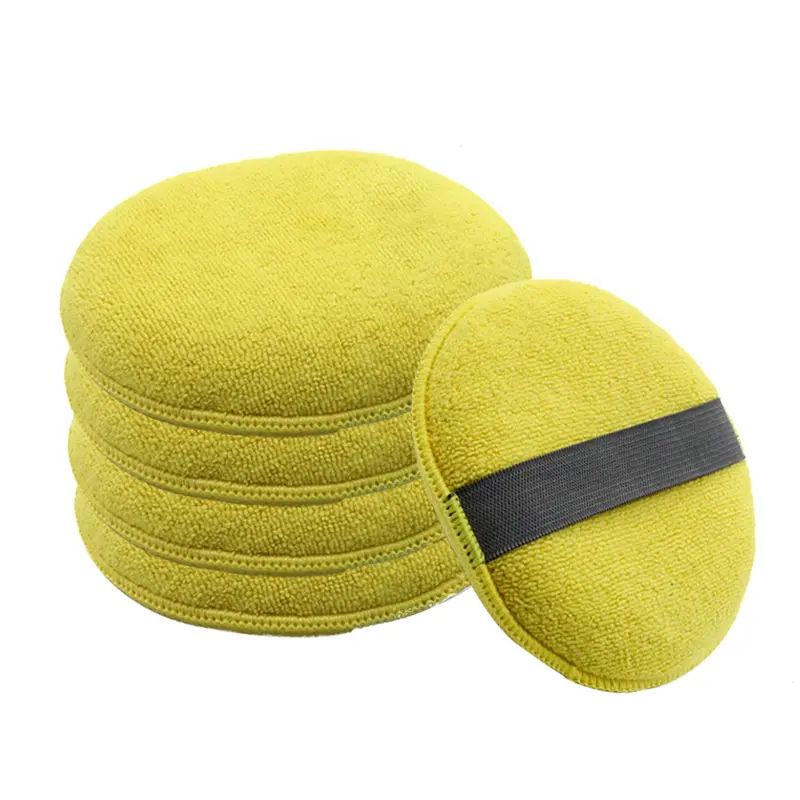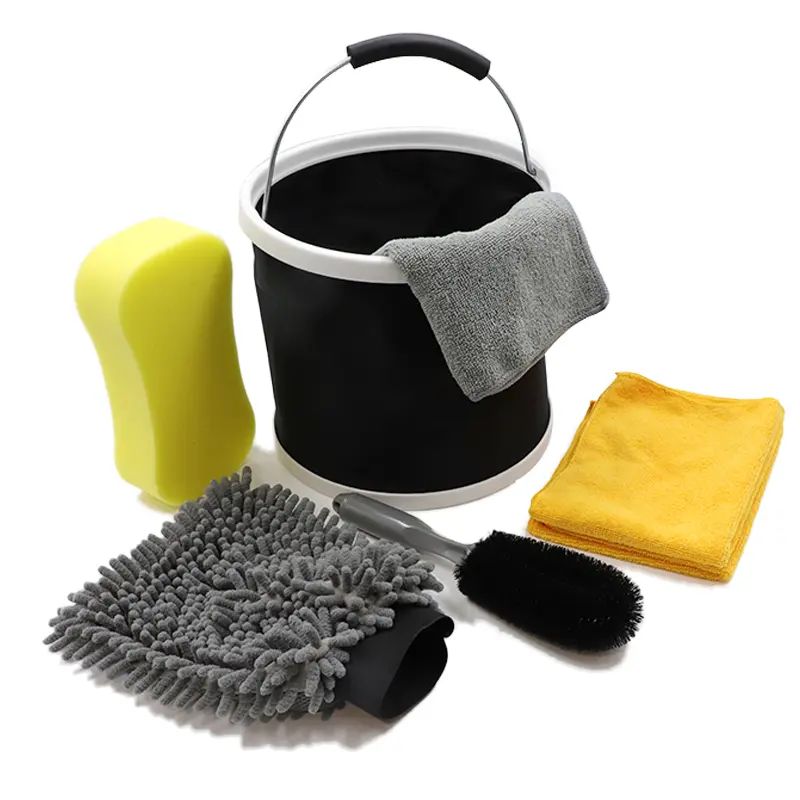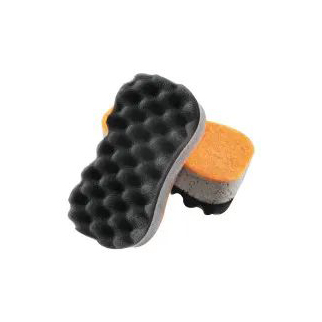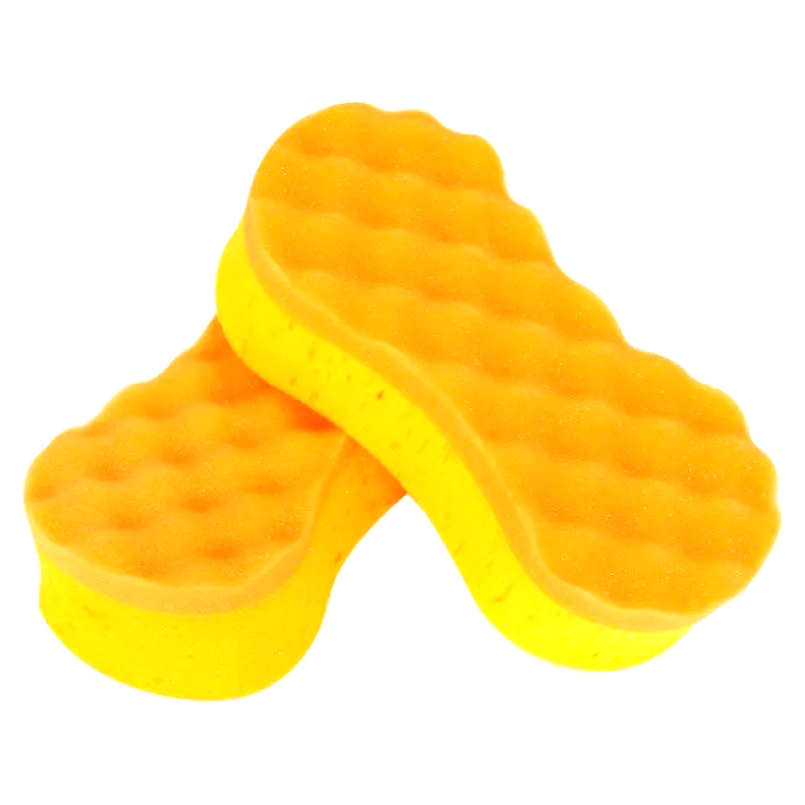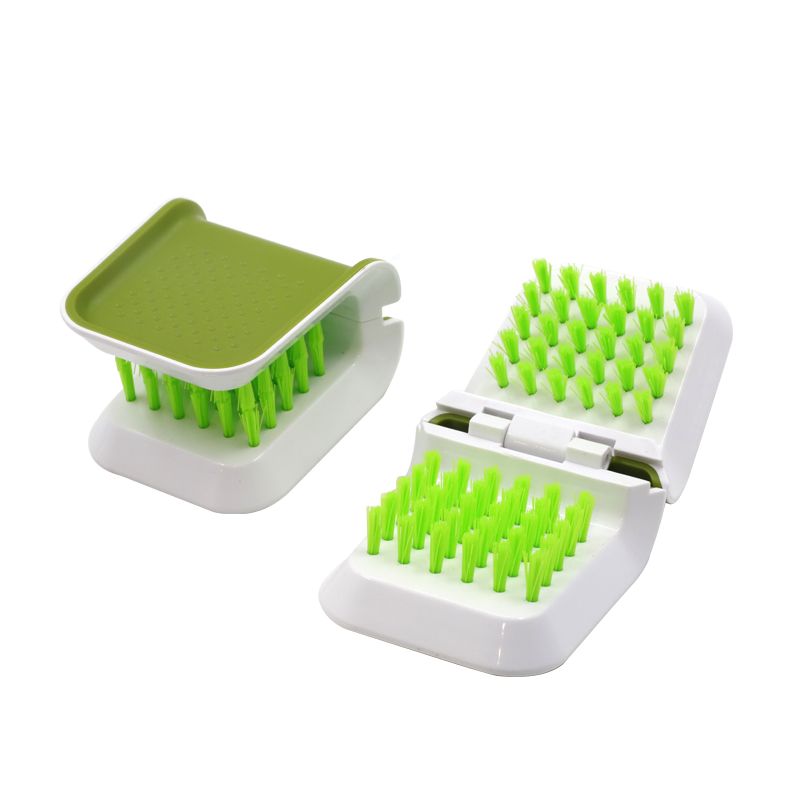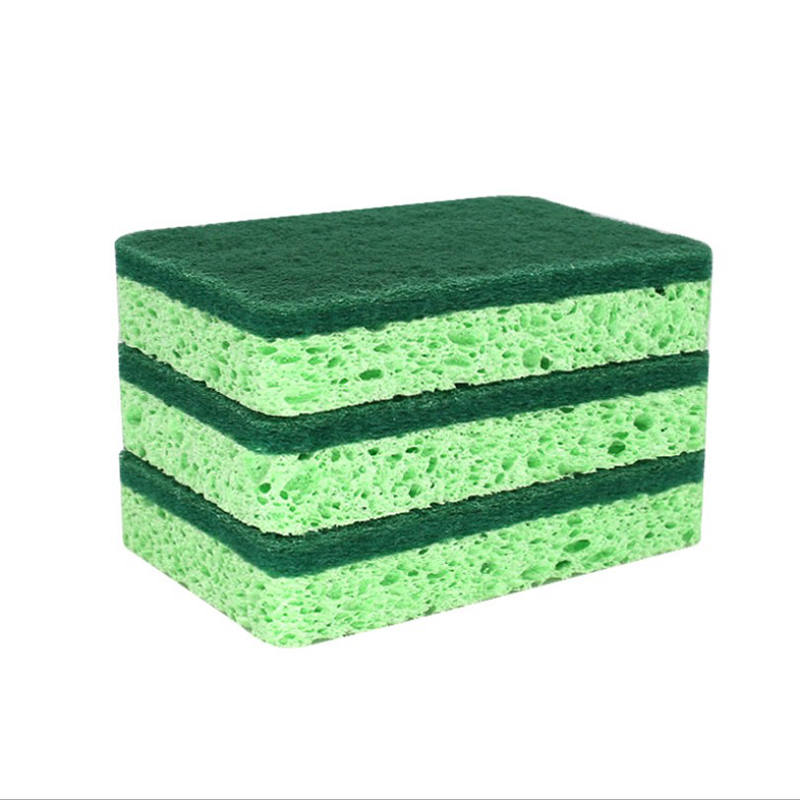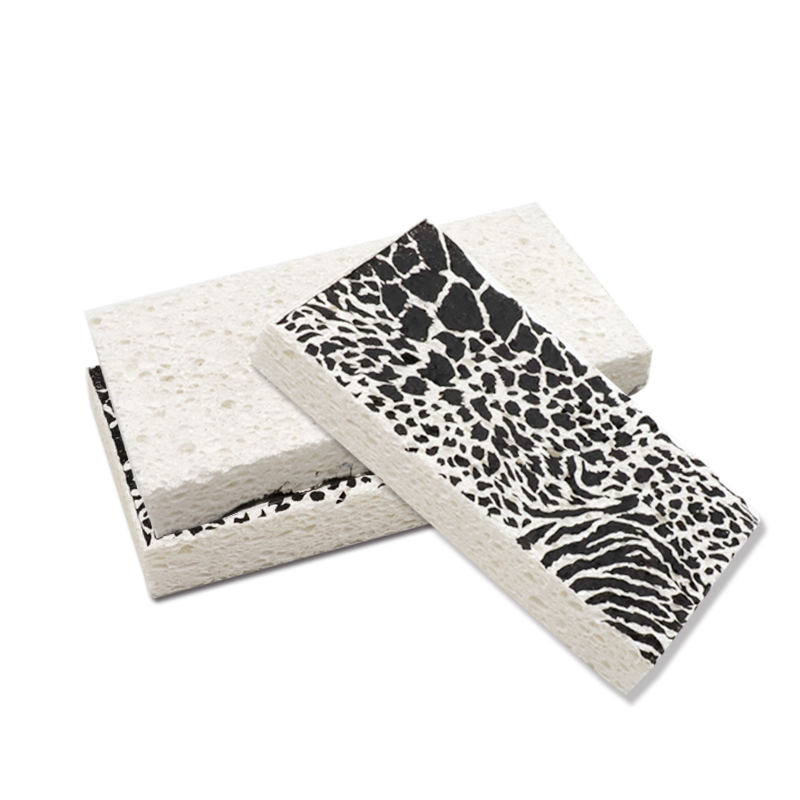راهنمای نهایی اسفنج های تمیز آشپزخانه: انواع ، کاربردها و نگهداری
1. Understanding Kitchen Clean Sponges: What Are They?
A kitchen clean sponge is one of the most versatile tools in any household. Though it may seem like a simple object, it plays a crucial role in maintaining cleanliness and hygiene in the kitchen. The kitchen sponge is designed to assist in various cleaning tasks, such as scrubbing dishes, wiping countertops, cleaning up spills, and tackling greasy surfaces. Understanding what a kitchen clean sponge is, the different types available, and the materials used to make it can help you choose the best one for your needs.
1.1 What Is a Kitchen Clean Sponge?
A kitchen clean sponge is an absorbent cleaning tool typically used for cleaning dishes, wiping down kitchen surfaces, and scrubbing off food residues. They are designed to soak up liquids, catch food particles, and scrub tough grime without damaging the surfaces they are used on. Kitchen sponges come in various shapes, sizes, and materials, each tailored to specific cleaning tasks.
The primary function of a kitchen sponge is to clean. However, it also serves as a tool to disinfect, remove stains, and scrub away grease or oils. Unlike other cleaning tools like towels or cloths, sponges provide an ideal balance of absorbency and scrubbing power, making them indispensable in the kitchen.
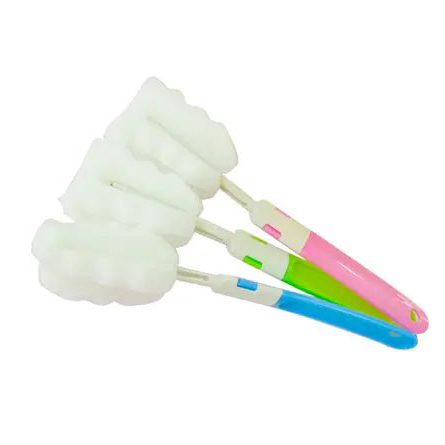
1.2 Materials Used in Kitchen Clean Sponges
Kitchen sponges are primarily made from a variety of materials that are both absorbent and capable of handling different cleaning tasks. Some sponges are made from natural, biodegradable substances, while others are synthetic. Let’s explore the most common materials used:
1.2.1 Cellulose Sponges
Cellulose sponges are made from plant fibers, typically derived from wood pulp or cotton. These sponges are highly absorbent, making them perfect for general cleaning tasks. The natural fibers in cellulose sponges allow them to soak up liquids and food particles quickly, which is why they are a go-to option for cleaning dishes, wiping counters, or cleaning up spills.
Key Features of Cellulose Sponges:
- Highly absorbent : They can hold several times their weight in water.
- Biodegradable : Since they are made from natural materials, they break down over time and are eco-friendly.
- Gentle on surfaces : These sponges are soft and will not scratch most surfaces, including non-stick cookware.
- Affordable and widely available : They are often inexpensive and easy to find in most supermarkets.
However, cellulose sponges can degrade quickly if not maintained properly. They are prone to bacteria growth, especially when left damp or dirty for too long. Regular cleaning and proper drying are essential to keep them hygienic.
1.2.2 Synthetic Foam Sponges
Synthetic foam sponges are made from materials such as polyurethane or other synthetic foam compounds. These sponges are durable, long-lasting, and generally resistant to bacteria buildup compared to natural sponges. They are available in a variety of shapes and sizes, often designed to fit specific tasks, such as scrubbing pots or cleaning delicate surfaces.
Key Features of Synthetic Foam Sponges:
- Durable : Synthetic foam sponges are usually more long-lasting than natural sponges.
- Resistant to mold : Unlike cellulose sponges, foam sponges are less likely to harbor bacteria and mold when properly cared for.
- Versatile : They come in different densities and textures, making them suitable for a wide range of cleaning tasks.
- Not biodegradable : These sponges are made from synthetic materials, so they are not as eco-friendly as cellulose sponges.
While synthetic sponges last longer, they can eventually wear out and become less effective. They also do not break down naturally, which may pose an environmental concern.
1.2.3 Scrub Sponges (With Abrasive Side)
Scrub sponges are a combination of a soft, absorbent sponge and a tougher, abrasive side made from materials such as nylon, steel wool, or other synthetic fibers. These sponges are designed for heavy-duty cleaning, such as scrubbing pots, pans, or removing baked-on food. They offer a strong scrubbing action without the need for harsh chemicals.
Key Features of Scrub Sponges:
- Effective on tough stains : The abrasive side helps to remove stubborn grime, grease, and food residues.
- Two-in-one design : Scrub sponges often have a soft sponge side for general cleaning and an abrasive side for heavy-duty tasks.
- Can scratch surfaces : While they are great for pots and pans, scrub sponges can scratch delicate surfaces like non-stick cookware, glass, or stainless steel.
Scrub sponges are great for tasks that require a bit more force, but they should be used with caution on sensitive surfaces to avoid scratching.
1.2.4 Natural Sponges
Natural sponges are made from the fibrous skeletons of sea creatures, typically harvested from the ocean. These sponges are known for being gentle on surfaces, highly absorbent, and naturally antibacterial. They are biodegradable, making them a sustainable option for eco-conscious individuals.
Key Features of Natural Sponges:
- Gentle on delicate surfaces : Natural sponges are perfect for cleaning delicate items like glassware and fine china.
- Biodegradable : They decompose naturally, which makes them an eco-friendly choice.
- Naturally antibacterial : Natural sponges resist bacterial growth due to their structure.
- Higher cost : Natural sponges tend to be more expensive compared to synthetic sponges.
Though natural sponges are gentle and eco-friendly, they can be harder to maintain, and they often require more frequent replacement than synthetic options.
1.3 How Do Kitchen Sponges Work?
Kitchen sponges work based on their ability to absorb and trap liquids, food particles, and debris. The pores within the material allow them to soak up liquids, while the texture and structure of the sponge help it scrub surfaces. When combined with cleaning agents like dish soap or water, sponges become highly effective at lifting grease, grime, and stains from kitchen surfaces.
1.3.1 Absorption
One of the main functions of a kitchen sponge is its ability to absorb liquids. The material used in the sponge, whether cellulose or synthetic foam, has an open-pore structure that allows it to soak up liquids and hold them within its fibers. This makes the sponge effective at cleaning up spills and washing dishes.
1.3.2 Scrubbing
In addition to absorption, many kitchen sponges have a rough texture that helps scrub away dirt and debris. This scrubbing action helps to remove food particles, grease, and even stains from pots, pans, and countertops. Some sponges even have an abrasive side to provide extra scrubbing power.
1.3.3 Removing Stains and Grease
Kitchen sponges are also capable of removing tough grease and stains from cookware and surfaces. The combination of the sponge’s absorbency and the cleaning agent used makes it possible to break down grease, oils, and stains and lift them away from the surface.
1.4 Choosing the Right Kitchen Clean Sponge
Choosing the right kitchen clean sponge depends on several factors, such as the type of cleaning task, the surfaces you’re cleaning, and your personal preferences. Here’s a quick guide on selecting the right sponge for your needs:
| Task | Best Sponge Type | Reason |
|---|---|---|
| Washing dishes | Cellulose Sponge | Soft, highly absorbent, gentle on delicate items. |
| Scrubbing pots and pans | Scrub Sponge (Abrasive Side) | Strong scrubbing power for tough stains. |
| Cleaning countertops | Cellulose or Foam Sponge | Gentle yet effective on most surfaces. |
| Cleaning delicate glassware | Natural Sponge | Soft and gentle, prevents scratching. |
| Heavy-duty grease cleaning | Synthetic Foam Sponge | Durable and resistant to mold. |
By understanding the materials and characteristics of each sponge type, you can make a more informed decision and ensure you’re using the best tool for the job.
2. Types of Kitchen Clean Sponges
When it comes to cleaning your kitchen, choosing the right sponge for the job can make a significant difference. Different sponges are designed with unique materials and features to tackle a variety of tasks, from washing dishes to scrubbing tough grease and grime.
2.1 Cellulose Sponges
Cellulose sponges are among the most commonly used sponges in kitchens due to their softness, absorbency, and biodegradability. They are typically made from plant-based cellulose fibers, which are derived from wood pulp or cotton. These sponges have a natural ability to soak up liquids, making them ideal for tasks that require significant moisture absorption.
Material:
Cellulose sponges are primarily composed of cellulose fibers, which are plant-based. The fibers are processed and bonded to form a sponge-like structure that is highly absorbent.
Best For:
- General cleaning : Cellulose sponges are great for everyday cleaning tasks, such as wiping countertops and cleaning up spills.
- Dishwashing : Due to their absorbency, these sponges are commonly used to clean dishes, pots, and pans.
- Wiping down surfaces : Cellulose sponges work well for wiping down smooth kitchen surfaces like countertops and tables.
Pros:
- Highly absorbent : Cellulose sponges can hold several times their weight in water, making them excellent for soaking up liquids quickly.
- Biodegradable : Since cellulose sponges are made from plant-based materials, they break down naturally over time and are an environmentally friendly option.
- Gentle on surfaces : These sponges are soft and gentle, making them safe to use on delicate kitchenware, such as non-stick pans, glassware, and countertops.
- Affordable : Cellulose sponges are typically low-cost and widely available in most supermarkets.
Cons:
- Can wear out quickly : While cellulose sponges are highly absorbent, they can degrade faster than other types of sponges if not properly maintained.
- Prone to bacteria growth : Like any sponge, cellulose sponges can harbor bacteria and mold if left damp for long periods. Proper cleaning and drying are essential to extend their lifespan.
- Not suitable for heavy-duty scrubbing : Due to their softness, cellulose sponges are not ideal for scrubbing tough grime, grease, or baked-on food.
2.2 Synthetic Foam Sponges
Synthetic foam sponges are made from materials like polyurethane foam or other synthetic compounds. These sponges are designed to be durable and versatile, capable of handling both light cleaning tasks and more heavy-duty scrubbing. They are often used for tasks where longevity and resistance to mold are essential.
Material:
Synthetic foam sponges are typically made from polyurethane foam, a durable, synthetic material that can be molded into various shapes and sizes. These sponges are often designed with different densities to provide varying levels of softness or abrasiveness.
Best For:
- Scrubbing pots and pans : Synthetic foam sponges are ideal for scrubbing greasy pots, pans, and utensils, particularly when used with dish soap.
- General cleaning : These sponges can be used to wipe down surfaces such as countertops, kitchen tables, and sinks.
- Heavy-duty cleaning : Due to their durability, synthetic foam sponges are better suited for cleaning tasks that require more abrasion or scrubbing power.
Pros:
- Durable : Synthetic foam sponges are more durable than natural sponges and can last longer with proper care.
- Resistant to mold : These sponges are less likely to harbor bacteria or mold compared to natural sponges, making them more hygienic.
- Good for scrubbing : Their dense foam structure makes them effective at scrubbing off grease, grime, and food residue.
- Versatile : Available in different shapes, sizes, and densities, synthetic foam sponges can be used for various cleaning tasks around the kitchen.
Cons:
- Less eco-friendly : Unlike natural sponges, synthetic foam sponges are made from petroleum-based materials, which means they are not biodegradable and contribute to environmental waste.
- Can be harsh on delicate surfaces : Depending on the density and texture, some synthetic sponges can scratch delicate surfaces, such as non-stick pans, if used improperly.
- May lose absorbency over time : While durable, synthetic foam sponges may lose their absorbency and scrubbing power after extended use.
2.3 Scrub Sponges (With Abrasive Side)
Scrub sponges are a hybrid design, featuring a soft, absorbent sponge on one side and a rough, abrasive surface on the other. This combination makes them ideal for heavy-duty cleaning tasks that require both absorbency and scrubbing power. The abrasive side is usually made from materials like nylon mesh or steel wool, providing the strength needed to tackle tough grease, grime, and food buildup.
Material:
Scrub sponges are typically made from a combination of a soft sponge base (usually synthetic foam or cellulose) and an abrasive side made from materials like nylon, polyester, or steel wool. The abrasive side can vary in coarseness depending on the intended use.
Best For:
- Heavy-duty scrubbing : Scrub sponges are perfect for tackling stubborn grease, food debris, and baked-on food on pots, pans, and cooking utensils.
- Tough stains : They are great for scrubbing stains off surfaces like countertops, stovetops, and ovens.
- Cleaning grills and outdoor cooking equipment : The abrasive side makes scrub sponges effective for cleaning outdoor grills and other equipment.
Pros:
- Excellent for tough stains : The abrasive side of scrub sponges provides extra scrubbing power, making them ideal for removing tough grease, burnt-on food, and stains.
- Versatile : Scrub sponges can handle a wide range of cleaning tasks, from light cleaning to heavy-duty scrubbing.
- Durable : The combination of materials makes these sponges long-lasting and resistant to wear.
Cons:
- Can scratch delicate surfaces : The abrasive side of scrub sponges can scratch delicate surfaces, including non-stick cookware, glass, and stainless steel. Care should be taken when using them on sensitive surfaces.
- Not suitable for light cleaning : Scrub sponges are designed for tougher cleaning tasks and may be too harsh for everyday use on delicate items or smooth surfaces.
2.4 Natural Sponges
Natural sponges are made from the fibrous skeletons of marine animals, particularly sea sponges. These sponges are known for their softness, absorbency, and eco-friendliness. They have been used for centuries as cleaning tools due to their natural antibacterial properties and gentle texture.
Material:
Natural sponges are harvested from the ocean, typically from species like Spongia or Hippospongia . Their fibrous skeletons are used to create soft, durable sponges that are biodegradable and environmentally friendly.
Best For:
- Eco-conscious users : Natural sponges are an excellent choice for those who want to minimize their environmental impact.
- Light cleaning tasks : They are perfect for cleaning delicate surfaces, including glassware, fine china, and countertops.
- Body sponges : Many people also use natural sponges for personal hygiene, such as bathing or exfoliating.
Pros:
- Biodegradable : Natural sponges are fully biodegradable, making them an environmentally friendly option.
- Gentle on surfaces : Natural sponges are incredibly soft and do not scratch delicate surfaces, such as glass or ceramics.
- Naturally antibacterial : Due to their unique structure, natural sponges resist the growth of bacteria and mold, making them more hygienic.
- Sustainable : Harvesting natural sponges from the ocean has a minimal environmental impact when done sustainably.
Cons:
- May not be as durable : While natural sponges are soft and absorbent, they are not as durable as synthetic sponges and may need to be replaced more frequently.
- Higher cost : Natural sponges tend to be more expensive than synthetic options due to the harvesting process and limited supply.
- Can be prone to wear and tear : Over time, natural sponges can degrade, especially if not properly cared for or dried after each use.
Choosing the right kitchen sponge depends on several factors, such as the cleaning task, the type of surface, and personal preferences regarding environmental impact. Here’s a quick comparison to help you choose the best sponge for your needs:
| Task | Best Sponge Type | Reason |
|---|---|---|
| Washing dishes | Cellulose Sponge | Soft, highly absorbent, gentle on delicate items. |
| Scrubbing pots and pans | Synthetic Foam Sponge | Durable and resistant to mold. |
| Heavy-duty scrubbing | Scrub Sponge (Abrasive Side) | Strong scrubbing power for tough stains. |
| Cleaning delicate glassware | Natural Sponge | Soft and gentle, prevents scratching. |
| Eco-friendly cleaning | Natural Sponge or Cellulose Sponge | Biodegradable and sustainable options. |
3. How to Use Kitchen Clean Sponges Effectively
Cleaning sponges are a staple in every kitchen. They help us maintain hygiene, remove grime, and keep surfaces spotless. It’s important to use them properly to maximize their effectiveness and ensure that you’re not spreading bacteria or damaging your kitchen surfaces.

General Cleaning
For everyday kitchen cleaning tasks, such as washing dishes, wiping down countertops, or cleaning appliances, the right sponge can make a significant difference. You want a sponge that is gentle enough to avoid scratching surfaces but effective enough to remove grease and food particles.
Types of Sponges for General Cleaning
-
Cellulose Sponges – These are soft sponges made from plant fibers. They are very absorbent and work well for cleaning delicate surfaces like countertops and dishes. They are perfect for everyday cleaning because they do not scratch surfaces and can hold a lot of water and soap.
-
Synthetic Foam Sponges – These sponges are made from man-made materials like polyester or polyurethane. They tend to be more durable than cellulose sponges and are also very absorbent. Synthetic foam sponges are ideal for everyday cleaning, as they are gentle yet effective at picking up grease and dirt.
How to Use a Sponge for General Cleaning
-
Dampen the Sponge – Start by wetting the sponge. A damp sponge works better than a dry one because it picks up dirt more effectively. When using dish soap, always apply a small amount directly onto the sponge to avoid wasting excess soap.
-
Dishwashing – When cleaning dishes, use circular motions to scrub the surfaces. The cellulose or synthetic foam sponge will help lift off grease and food particles without damaging the surface of your dishes.
-
Wiping Down Surfaces – For countertops, stovetops, and other kitchen surfaces, dampen your sponge with water and wipe in a gentle, sweeping motion. For sticky or greasy spots, add a few drops of dish soap for better grease-cutting action.
Tough Stains and Scrubbing
Some areas in the kitchen will require more heavy-duty cleaning. Greasy pans, burnt food, or stubborn stains are all common challenges in the kitchen. While regular sponges work for daily tasks, you need a stronger tool for tougher stains and baked-on grime.
Types of Sponges for Tough Stains
-
Scrub Sponges – These sponges typically have two sides: one soft and one abrasive. The abrasive side is usually made from materials like nylon, polyester, or other synthetic fibers. This side is excellent for scrubbing stubborn stains, baked-on food, and greasy pans.
-
Scouring Pads – These are typically made of steel wool or a similar abrasive material. They are ideal for tackling extremely tough grime but should be used with care to avoid damaging delicate surfaces.
How to Use a Sponge for Tough Stains
-
Choosing the Right Sponge – If you need to scrub pots and pans with tough stains, use a scrub sponge with an abrasive side. For lighter stains, a non-abrasive sponge is still sufficient.
-
Wet and Apply Dish Soap – Dampen your scrub sponge with water before applying a small amount of dish soap to the abrasive side. This will help break down the grease and make scrubbing more effective.
-
Scrubbing – For baked-on food, use the abrasive side of the sponge and scrub in circular motions. For pots and pans, focus on the areas where food is most stuck. However, be cautious not to apply excessive pressure, as this can damage the surface of your cookware.
-
Tough Stains on Surfaces – For stubborn stains on countertops or sinks, use the scrub sponge but avoid using it on delicate surfaces such as non-stick cookware or glass, as it may cause scratching.
Countertops and Sinks
Your kitchen countertop and sink require special care when cleaning. These areas are prone to collecting bacteria, food particles, and grime. Whether your countertops are made of granite, marble, or laminate, it’s important to choose the right sponge to clean them effectively while preserving their surface.
How to Clean Countertops
-
Use a Soft Sponge – For granite, marble, and laminate countertops, always use a soft sponge, such as a cellulose sponge, to prevent scratching the surface.
-
Disinfecting Countertops – After wiping down your counters with a damp sponge, you should use a disinfectant to kill germs. A mild dish soap solution can also be used for regular cleaning. For granite and marble, avoid using acidic cleaners, as they can damage the stone.
-
Wipe in One Direction – When cleaning countertops, wipe in a consistent direction to prevent pushing dirt and bacteria around. This will also ensure a smoother finish after cleaning.
How to Clean Sinks
-
Choose the Right Sponge for the Sink – If you have a stainless steel sink, you can use a scrub sponge with a soft side to clean the surface. For ceramic or porcelain sinks, a non-abrasive sponge should be used to avoid damaging the finish.
-
Scrub the Sink – Start by scrubbing the sink basin with your damp sponge, paying attention to any stains or debris stuck in the corners. You may want to use a mild dish soap or a sink-specific cleaner to lift grime effectively.
-
Disinfect the Sink – After cleaning, use a disinfectant or a solution of water and vinegar to wipe down the sink. This will help kill bacteria and prevent odors.
Special Considerations for Sensitive Surfaces
Some surfaces in your kitchen are more sensitive than others and require extra care to avoid scratches, discoloration, or damage. Here are a few considerations for cleaning delicate surfaces:
-
Non-Stick Cookware – When cleaning non-stick pans, use only a soft sponge or a non-abrasive cloth. Scrub gently to avoid damaging the non-stick coating. Never use a metal scrubber or abrasive sponge, as this will strip the coating and lead to food sticking.
-
Glass and Ceramic – For glass surfaces like glass stovetops or ceramic sinks, always use a non-abrasive sponge to prevent scratching. A soft cellulose sponge works best for these surfaces.
-
Stone Surfaces – If you have granite, marble, or quartz countertops, avoid using harsh chemicals or abrasive sponges. Always use a soft sponge, and clean with mild dish soap or a pH-balanced cleaner to protect the stone.
-
Wooden Surfaces – Wooden cutting boards or countertops should not be cleaned with soaking wet sponges, as the moisture can damage the wood. Instead, lightly dampen the sponge and avoid using too much water. After cleaning, make sure to dry the surface immediately.
Proper Care and Maintenance of Sponges
To ensure that your sponges last longer and remain hygienic, it’s important to clean and maintain them regularly.
-
Rinse After Each Use – After using your sponge, rinse it thoroughly with hot water to remove any food particles or soap residue. Squeeze out as much water as possible to prevent bacteria from growing.
-
Disinfect Sponges – To eliminate germs and bacteria, disinfect your sponges regularly. You can microwave a damp sponge for 1-2 minutes to kill bacteria or soak it in a bleach solution for a few minutes.
-
Replace Sponges Periodically – Sponges can harbor bacteria over time, so it’s essential to replace them every 1-2 weeks, depending on usage. If your sponge starts to look worn out, torn, or has an unpleasant odor, it’s time to replace it.
4. Maintaining Your Kitchen Clean Sponge
A kitchen sponge is one of the most essential tools in keeping your kitchen clean, but it also requires proper maintenance to ensure its effectiveness and hygiene. Sponges are prime breeding grounds for bacteria, especially if they are not properly cared for. Regular cleaning, drying, and replacing of sponges can make a huge difference in maintaining a sanitary and long-lasting tool.
Rinsing After Each Use
The first and most basic step in maintaining your kitchen sponge is to rinse it thoroughly after each use. This helps to remove any food particles, soap residue, or cleaning agents that may remain in the sponge.
Why Rinsing is Important
When you wash dishes, wipe surfaces, or scrub pots and pans, food particles, grease, soap, and cleaning chemicals often get trapped inside the sponge. If left unchecked, these residues can harbor bacteria and other microorganisms. Rinsing your sponge immediately after use helps to reduce the chances of these harmful elements building up. It also makes sure that the sponge stays cleaner for longer and works more effectively.
How to Rinse Properly
-
Run Under Hot Water – Hold the sponge under running hot water to help loosen food particles and residue. The hot water will help break down oils and grease, making it easier to remove any trapped debris.
-
Squeeze Out Excess Water – Once you’ve rinsed the sponge, squeeze it firmly to get rid of excess water. This not only helps in drying the sponge faster but also prevents it from retaining water, which could lead to bacteria growth.
-
Rinse Immediately After Use – It’s essential to rinse the sponge immediately after cleaning to prevent food particles from drying inside. If you leave a sponge wet with food residue, it may start to smell quickly and become a breeding ground for bacteria.
Disinfecting Your Sponge
Even with proper rinsing, sponges are still susceptible to bacterial growth. Because sponges stay moist for extended periods and come into contact with food residues, they can become a hotspot for germs. Disinfecting your sponge regularly can kill bacteria and prevent odors, ensuring your sponge remains hygienic.
Methods for Disinfecting Your Sponge
-
Microwave Method
Microwaving your sponge is one of the easiest and most effective ways to disinfect it. The heat from the microwave kills harmful bacteria and germs.-
Step-by-Step Process :
- Wet the sponge thoroughly. A dry sponge could catch fire in the microwave, so always ensure it’s damp.
- Place the wet sponge in the microwave.
- Heat it on high for 1-2 minutes. This will kill most bacteria and viruses.
- Let the sponge cool before using it again.
Note : Microwaving is most effective for sponges that do not contain metallic parts, such as scrubbers with wire mesh or any other metallic components.
-
-
Dishwasher Method
A dishwasher is another excellent option for cleaning your sponge. The high heat from the dishwasher’s drying cycle will help kill germs and sanitize the sponge.-
Step-by-Step Process :
- Place the sponge on the top rack of your dishwasher.
- Run the dishwasher on a hot cycle. The heat from the water and the drying cycle will sanitize the sponge.
- Allow the sponge to air dry after the cycle is complete.
Note : This method works well if you use your dishwasher frequently and are looking for a convenient way to disinfect your sponge along with your dishes.
-
-
Vinegar Solution
A natural and chemical-free way to disinfect your sponge is by using vinegar, which is known for its antibacterial properties. This method is gentle and effective.-
Step-by-Step Process :
- Mix equal parts of white vinegar and water in a small bowl or container.
- Soak the sponge in the mixture for 5-10 minutes.
- Rinse the sponge thoroughly with water after soaking.
- Allow the sponge to air dry before using it again.
Note : Vinegar is a safe, non-toxic disinfectant, but it may not be as effective in killing all bacteria as methods involving heat.
-
-
Bleach Solution
For a deeper clean, especially if your sponge has developed an unpleasant odor or has been used on highly contaminated surfaces, a bleach solution can work wonders.-
Step-by-Step Process :
- Mix 1 tablespoon of bleach with 1 quart of water in a small bowl or container.
- Soak the sponge in the bleach solution for about 5 minutes.
- Rinse the sponge thoroughly with warm water to remove any bleach residue.
- Allow the sponge to air dry.
Note : Be cautious with bleach, as it can weaken sponges over time. Only use this method when absolutely necessary, and avoid using bleach on colored sponges as it may cause fading.
-
Replace Regularly
While regular rinsing and disinfecting can extend the life of your sponge, all sponges eventually wear out and become less effective. Even with proper maintenance, a sponge will degrade over time and may harbor bacteria despite your best efforts. It’s important to replace your kitchen sponge regularly to ensure it remains hygienic and effective.
Signs It’s Time to Replace Your Sponge
-
Foul Odor – One of the most obvious signs that your sponge needs to be replaced is if it develops a persistent, unpleasant smell. This odor is often caused by bacteria and mold growing in the sponge, and it’s usually a sign that the sponge is no longer sanitary.
-
Visible Wear and Tear – If your sponge has visible holes, fraying edges, or looks torn, it’s no longer effective for cleaning. These tears can trap bacteria and reduce the sponge’s ability to clean properly.
-
Discoloration – If the sponge becomes discolored or stained, especially in areas that have been in contact with raw meat or other contaminants, it may be best to replace it. Stains can indicate bacterial growth that can’t be fully eliminated by cleaning alone.
-
Reduced Effectiveness – Over time, the sponge will lose its absorbency and cleaning power. If the sponge doesn’t hold water or soap as well as it used to, it’s time to replace it.
How Often Should You Replace Your Sponge?
Most experts recommend replacing your kitchen sponge every 1-2 weeks , depending on usage. If you use it frequently or for tasks like cleaning raw meat residue or scrubbing heavily soiled surfaces, you may need to replace it more often.
Tip : If you have a large family or do a lot of cooking, consider having more than one sponge on hand so that you can rotate them regularly. This will help you extend the life of each sponge and ensure that you always have a clean one ready to use.
Storing Your Sponge Properly
Proper storage of your sponge can also help prolong its lifespan and reduce bacterial growth. When sponges are left in damp, dark places, they are more likely to harbor bacteria and develop odors.
-
Store in a Dry Area – After cleaning, always squeeze out as much water as possible and store the sponge in a well-ventilated area where it can dry quickly. Avoid leaving it in a closed, damp place such as a kitchen drawer or under the sink.
-
Use a Sponge Holder – Consider using a sponge holder or rack that allows the sponge to air dry between uses. A sponge holder with good drainage will help ensure that the sponge dries out completely and doesn’t sit in stagnant water.
-
Avoid Keeping It in the Sink – Do not leave your sponge sitting in the sink, as the moisture and food debris can encourage bacterial growth. Always rinse and store it in a dry location.
5. Eco-Friendly Kitchen Sponges: Sustainable Choices
In today’s world, sustainability is more important than ever, especially when it comes to everyday products like kitchen sponges. Traditional sponges, often made of synthetic materials, can contribute to plastic waste and environmental degradation. Fortunately, there are a variety of eco-friendly alternatives that provide the same cleaning power without the environmental toll.
Why Choose Eco-Friendly Sponges?
The need for eco-friendly sponges stems from the increasing awareness of plastic pollution and its harmful effects on the environment. Conventional kitchen sponges are typically made from petroleum-based materials, like polyurethane, which are not biodegradable and can take hundreds of years to break down in landfills. By switching to sustainable alternatives, you can minimize your environmental footprint and contribute to a cleaner planet.
Moreover, many eco-friendly sponges are made from natural, biodegradable materials, meaning they decompose much more quickly than synthetic options. This reduces waste and the need for frequent replacements, saving you money in the long run.
Let’s dive into some of the top eco-friendly kitchen sponge options available today.
Bamboo Sponges
One of the most popular and sustainable alternatives to traditional sponges is the bamboo sponge . Bamboo is an incredibly fast-growing plant that is highly renewable and requires minimal water or pesticides to grow. This makes it a perfect material for creating eco-friendly sponges.
Benefits of Bamboo Sponges
-
Biodegradable – Bamboo sponges are made from bamboo fibers, which are 100% biodegradable. Once the sponge has reached the end of its useful life, it will break down naturally, leaving no harmful waste behind.
-
Gentle on Surfaces – Bamboo sponges are usually soft and gentle on kitchen surfaces. They are great for everyday use, including wiping down counters, washing dishes, and scrubbing pots and pans without causing damage.
-
Durable and Long-Lasting – Bamboo is a highly durable material, which means bamboo sponges can last longer than conventional synthetic sponges. They maintain their effectiveness over time, reducing the need for frequent replacements.
-
Naturally Antibacterial – Bamboo is known for its natural antibacterial properties. This helps prevent bacteria buildup in the sponge, making it a more hygienic option for kitchen cleaning.
How to Use and Care for Bamboo Sponges
-
Usage : Bamboo sponges are ideal for regular cleaning tasks such as dishwashing, countertop wiping, and general kitchen cleaning. They are best used with a small amount of dish soap or detergent.
-
Care : After each use, rinse the bamboo sponge thoroughly and allow it to air dry in a well-ventilated area. It is essential to dry the sponge after each use to prevent mold growth and maintain its longevity.
Bamboo Sponge Pros and Cons
| Pros | Cons |
|---|---|
| Biodegradable and compostable | Can be less abrasive than synthetic sponges |
| Made from a renewable resource | May not last as long as synthetic sponges in some cases |
| Naturally antibacterial | Requires proper care to avoid mold |
| Gentle on surfaces | Might need to be replaced more frequently than synthetics |
Loofah Sponges
Another eco-friendly sponge option is the loofah sponge , which is made from the fibrous interior of the loofah plant, a type of gourd grown in tropical and subtropical regions. Loofahs have been used for centuries for cleaning and scrubbing due to their natural ability to exfoliate.
Benefits of Loofah Sponges
-
Compostable – Loofah sponges are 100% natural and completely compostable. When you’re done with them, you can toss them in the compost bin, where they will break down without contributing to landfill waste.
-
Gentle on Skin – Loofah sponges are especially gentle on the skin, making them a great choice for people with sensitive skin or those looking for a more natural exfoliant. They can be used in the kitchen for cleaning delicate surfaces without causing scratches.
-
Effective Scrubbing Power – While loofahs are soft, they still have excellent scrubbing power. They can easily remove grease, grime, and food residues from various kitchen surfaces.
-
Sustainable and Renewable – Loofah plants grow quickly and are easy to cultivate without the need for heavy pesticide use, making them a sustainable option for eco-conscious consumers.
How to Use and Care for Loofah Sponges
-
Usage : Loofah sponges are great for scrubbing pots, pans, and dishes. They also work well for wiping down countertops and sinks. For tougher stains, a loofah can be combined with a small amount of dish soap for enhanced cleaning power.
-
Care : Loofah sponges are easy to clean. Simply rinse thoroughly after each use and allow it to dry completely between uses. It’s important to keep the sponge dry to avoid bacterial growth.
Loofah Sponge Pros and Cons
| Pros | Cons |
|---|---|
| 100% biodegradable | Can become rough over time without proper care |
| Natural, plant-based material | May be less effective on sticky or greasy surfaces |
| Great for delicate surfaces | Needs to be replaced regularly due to wear and tear |
Reusable Sponge Cloths
Reusable sponge cloths are a versatile and highly sustainable option for those looking to reduce waste. These cloths are made from a combination of natural fibers like cotton and cellulose, which are biodegradable and durable. They can be washed and reused multiple times, making them an economical and eco-friendly choice.
Benefits of Reusable Sponge Cloths
-
Washable and Reusable – Unlike traditional sponges, sponge cloths can be washed in the washing machine or by hand and used repeatedly. This reduces the amount of waste generated by disposable sponges.
-
Highly Absorbent – Sponge cloths are known for their impressive absorbency. They can hold a large amount of water, making them perfect for cleaning countertops, dishes, and even spills.
-
Biodegradable – Made from natural fibers, reusable sponge cloths are fully biodegradable and can be composted at the end of their life.
-
Durable and Long-Lasting – With proper care, reusable sponge cloths can last for months. This makes them a more cost-effective and eco-friendly alternative to single-use synthetic sponges.
How to Use and Care for Reusable Sponge Cloths
-
Usage : Sponge cloths are ideal for wiping surfaces, mopping up spills, and cleaning dishes. They are also great for use on sensitive surfaces like glass and granite.
-
Care : After each use, rinse the sponge cloth thoroughly and hang it to dry. It’s important to wash it regularly to prevent odors or bacteria buildup. You can machine wash them or wash them by hand with a mild detergent.
Reusable Sponge Cloth Pros and Cons
| Pros | Cons |
|---|---|
| Washable and long-lasting | May take longer to dry than synthetic sponges |
| Highly absorbent | Can lose shape over time with frequent use |
| Biodegradable and compostable | May not have the scrubbing power of more abrasive options |
Comparing Eco-Friendly Sponge Options
| Sponge Type | Material | Biodegradable | Compostable | Durability | Scrubbing Power |
|---|---|---|---|---|---|
| Bamboo Sponges | Bamboo fibers | Yes | Yes | High | Moderate |
| Loofah Sponges | Loofah plant fibers | Yes | Yes | Moderate | High |
| Reusable Sponge Cloths | Cotton and cellulose fibers | Yes | Yes | Very High | Low |
6. Common Mistakes to Avoid with Kitchen Clean Sponges
Kitchen sponges are essential tools in maintaining a clean and hygienic cooking space, but many people make common mistakes when using them. These errors not only reduce the effectiveness of the sponge but can also lead to bacteria buildup and even damage to kitchen surfaces. By understanding and avoiding these mistakes, you can ensure that your kitchen sponges work effectively, last longer, and help keep your kitchen safe and sanitary.
Using the Wrong Sponge for the Job
One of the most significant mistakes you can make when using a kitchen sponge is not matching the type of sponge to the cleaning task at hand. Kitchen sponges come in various types, each designed for specific purposes. Using the wrong sponge can lead to ineffective cleaning and even damage your kitchen surfaces.
Why Sponge Selection Matters
Different kitchen surfaces and cleaning tasks require different levels of abrasion and absorbency. For example, a delicate surface like non-stick cookware or glass countertops needs a soft, non-abrasive sponge to avoid scratching. On the other hand, tough stains on pots and pans may require a more abrasive sponge.
Using the wrong type of sponge can result in scratches, reduced cleaning efficiency, and a greater risk of cross-contaminating food with bacteria.
Types of Sponges and Their Best Uses
-
Soft Cellulose Sponges
- Best for : Everyday cleaning, wiping down counters, dishes, and other smooth surfaces.
- Why : These sponges are soft and absorbent, making them ideal for cleaning delicate surfaces without causing scratches.
- Mistake to Avoid : Don’t use a soft sponge for tough, baked-on food or greasy pots and pans, as it may not have the scrubbing power needed.
-
Abrasive Scrub Sponges
- Best for : Scrubbing stubborn stains, baked-on food, and greasy pans.
- Why : These sponges feature a rough side designed to handle tough cleaning tasks. However, they can damage delicate surfaces.
- Mistake to Avoid : Never use abrasive sponges on non-stick cookware, glass, or marble countertops, as they can leave scratches.
-
Microfiber Sponges
- Best for : Dusting, wiping down surfaces, and cleaning glass or stainless steel.
- Why : Microfiber is gentle and excellent at picking up dirt and debris without leaving streaks or scratches.
- Mistake to Avoid : Avoid using microfiber sponges on surfaces that require scrubbing or heavy-duty cleaning, as they don’t have enough abrasion.
-
Natural Sponges (Loofah)
- Best for : Gentle cleaning, especially on delicate surfaces like glass, ceramic, or countertops.
- Why : Loofah sponges are soft, absorbent, and biodegradable. They are ideal for everyday cleaning tasks without damaging surfaces.
- Mistake to Avoid : Avoid using loofah sponges for heavy-duty scrubbing, as they don’t have the abrasiveness needed to tackle tough stains.
How to Choose the Right Sponge for the Job
When selecting a sponge, always consider the surface and the type of cleaning required. If in doubt, choose a soft sponge and gradually increase the abrasiveness depending on how tough the stain or mess is. When dealing with delicate materials or non-stick cookware, always err on the side of caution and use a gentle sponge.
Not Drying the Sponge Properly
After each use, many people make the mistake of leaving their sponge damp or wet, which can lead to bacterial growth, foul odors, and the rapid deterioration of the sponge itself. A damp sponge is an ideal environment for bacteria, mold, and mildew to thrive. It’s essential to dry your sponge thoroughly after each use to maintain cleanliness and prevent contamination.
Why Drying the Sponge Is Critical
When a sponge is left damp or wet, it holds onto moisture, creating a breeding ground for bacteria. Since sponges are frequently exposed to food particles, grease, and soap, moisture combined with these residues can lead to harmful bacteria growth, such as E. coli and Salmonella. Allowing your sponge to dry properly reduces the risk of bacterial buildup and keeps your kitchen clean.
How to Properly Dry a Sponge
-
Squeeze Out Excess Water – After using your sponge, always wring it out thoroughly to remove as much water as possible. This helps the sponge dry more quickly and prevents it from staying soggy.
-
Air Dry the Sponge – Always place your sponge in a well-ventilated area to dry. Avoid leaving it in a closed container, sink, or drawer, as these spaces trap moisture and contribute to bacterial growth.
-
Use a Sponge Holder – Consider using a sponge holder with drainage to allow the sponge to dry more efficiently between uses. Sponge holders designed with slits or holes let the air flow freely, helping the sponge dry quickly and thoroughly.
-
Microwave for Quick Drying – For extra precaution, you can microwave a damp sponge for 1-2 minutes to kill any bacteria and speed up the drying process. Just make sure the sponge is wet to avoid the risk of fire.
Common Mistakes to Avoid
- Leaving your sponge in a wet, enclosed space (such as under the sink).
- Using the sponge while it’s still wet or moist, which can spread bacteria instead of cleaning effectively.
- Not wringing out excess water after each use, which can prolong drying time.
Ignoring Signs of Wear and Tear
Ignoring the condition of your kitchen sponge can lead to cross-contamination and ineffective cleaning. Over time, sponges degrade, become worn out, and may harbor bacteria that can affect the cleanliness of your kitchen. Recognizing when a sponge is no longer useful and replacing it promptly is crucial for maintaining a hygienic kitchen.
Signs Your Sponge Needs Replacing
-
Foul Odor
A strong, unpleasant smell coming from your sponge is a clear indication that it has become a breeding ground for bacteria. When a sponge starts to smell, it means that the bacteria have proliferated, and the sponge is no longer hygienic. At this point, it’s time to discard it. -
Visible Wear and Tear
If your sponge is falling apart, showing visible rips or fraying, it can no longer clean effectively. A sponge that’s falling apart may leave fibers behind or fail to pick up dirt and debris, reducing its cleaning efficiency. -
Staining or Discoloration
Sponges that become discolored or stained from food residues, especially from raw meats or spills, are likely to harbor harmful bacteria. While some staining is normal, persistent discoloration indicates that the sponge is no longer effectively sanitized. -
Loss of Absorbency
Sponges that have lost their ability to absorb water and soap are no longer effective at cleaning. If your sponge feels dry or hard despite being dampened, it’s a sign that it’s reached the end of its useful life.
How Often Should You Replace Your Sponge?
It’s generally recommended to replace your kitchen sponge every 1-2 weeks , depending on usage. If your sponge is used daily for heavy-duty tasks, such as scrubbing greasy pans or cleaning raw meat residue, you may need to replace it more frequently. Additionally, if you notice any of the signs mentioned above, it’s time to swap out your old sponge.
Benefits of Replacing Your Sponge Regularly
-
Hygiene – Replacing your sponge regularly helps prevent the buildup of harmful bacteria and ensures that you are using a clean tool for every cleaning task.
-
Effectiveness – A fresh sponge works much better than a worn-out one, providing more absorbency and cleaning power. This leads to faster and more efficient cleaning.
-
Reduced Odors – A new sponge is less likely to develop odors, ensuring that your kitchen smells fresh and clean after every use.
Common Sponge Mistakes and Solutions
| Mistake | Description | Solution |
|---|---|---|
| Using the wrong sponge for the job | Using abrasive sponges on delicate surfaces can cause scratches or damage. | Always match the sponge type to the cleaning task (soft sponges for delicate, abrasive for tough stains). |
| Not drying the sponge properly | A damp sponge is a breeding ground for bacteria and mildew. | Squeeze out excess water and air-dry the sponge to prevent bacterial growth. |
| Ignoring signs of wear and tear | Worn-out sponges can harbor bacteria, develop odors, and lose effectiveness. | Replace sponges regularly (every 1-2 weeks) and when they show signs of damage or odor. |
قبلیNo previous article
بعداز اسفنج ها گرفته تا گیاهان طبیعی: چگونه اسفنج حمام مناسب را برای پوست و سیاره خود انتخاب کنید
دسته بندی اخبار
- اخبار شرکت(31)
- اخبار صنعت(114)

 简体中文
简体中文